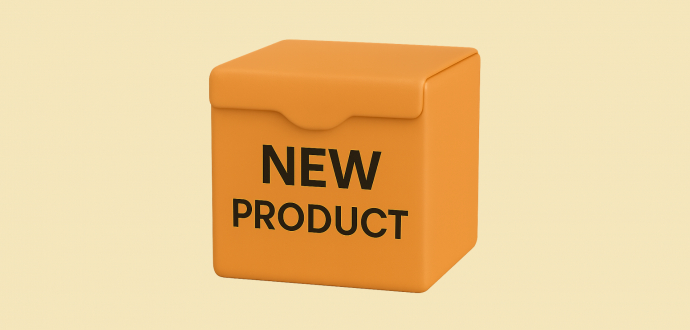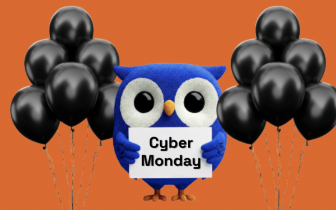How to Name a Product That Sells

Products are not alive and animated. They are not living souls, unlike humans. Yet, their names can outlive people’s names by years and even centuries.
Unlike people’s names, which are inevitably repeated millions of times within one country and even across nations, product names are predominantly unique. This makes them even more impactful, and the product naming process becomes a more responsible undertaking.
Join us today for an exciting journey into the art and science of product naming. In a few pages, we’ll tell you how to name a product that actually sells, stands out on the market, and improves your business resilience.
Why product names matter for sales
In the constant noise of the digital world, when shopping is done in bizarre places like social networks, messaging apps, livestreams, and even gaming platforms, product naming is more important than ever.
Research indicates that 77% of shoppers rely on the brand name alone to determine what they buy. One recent study found that 60% of consumers avoid products with unappealing names. These statistics underpin what many of us know by heart and feel every time we go shopping.
Even in a sea of flashy ads, people still reach for names that feel familiar and trustworthy. A clever title on the shelf or a snappy label online can tilt the whole decision. That tiny cluster of syllables carries more influence than a page of specs.
What is a product name?
It’s the short, memorable tag that separates your offer from every other look-alike. More than a label, it’s a promise your audience repeats whenever they think about buying or recommending you.
Before jumping into the practicalities of naming a product, keep these fundamentals at the front of your mind:
- First impressions stick; names shape those instant judgments.
- Clear wording explains value faster than complicated feature charts.
- Memorable names travel farther through casual, unpaid word-of-mouth.
- Short syllables help voice assistants pronounce your brand correctly.
- Meaningful references trigger emotions and strengthen brand loyalty.
A product name is the anchor, the north star of your brand. It guides customers in times of uncertainty and when competitors bombard the market with similar product names, trying to copy your success.
If you manage to come up with a memorable, positive, and innovative (unique) product name, chances are your sales will rise, guaranteeing your product and brand a strategic market success that may even outlive you and your business.
The psychology behind effective product names
Perhaps, in nine out of ten articles about marketing, the authors aim to skip theories and move straight to the practical part. However, with giving products names, it's different. So much is at stake in those few words that ignoring psychology would be careless.
Emotion, not logic, fires first when shoppers scan a shelf. A name that clicks with that spark can tip the scale before price or features enter the picture. That’s why product naming is more psychology class than wordplay contest.
Certain cues work like shortcuts in the brain. We gravitate toward sounds that feel friendly, visuals that promise comfort, and names that hint at reward. Miss those cues, and even a great product may stall.
- Soft sounds signal comfort and everyday friendly use.
- Hard stops add punch, conveying strength or durability.
- Three-word phrases tell mini-stories, fueling imagination quickly.
- Hidden metaphors spark curiosity and post-purchase pride.
- Balanced syllables roll smoothly in spoken recommendations.
That blend of sound and meaning earns a passport to the customer’s long-term recall. Years later, they may forget the ad, but your name still pulls them back like a familiar song hook.
For a product to sell well, consumers must trust it. Research shows that for 81% of buyers, trust in a brand is paramount and defines their purchasing decisions.
Earning that trust requires hard work, but losing it can happen within minutes, and the trust may never come back, so to speak. So many brands recklessly damage their reputation by subpar quality, bad ad campaigns (e.g., against ethics), or intentional competitor defamation, but later struggle for years to gain the consumers’ trust back, often without success.
Characteristics of high-converting product names
Some product names live and prosper for decades, driving steady sales and winning customer loyalty, while others don’t. How come? What’s in the high-converting product names that makes them more successful than 99% of other names on the market within the same niche?
Actually, many things are at play here. Let’s explore the few main ones.
1. Built-in recall
Catchy rhythm or gentle and positive analogy can lodge a name in memory after one reading. Our brains love patterns, and a three-beat rhythm often does the trick.
Want examples? Here are some well-known brand names with built-in recall:
- Coca-Cola – Double alliteration and identical stress pattern (co-CA co-LA) create a singsong feel.
- KitKat – Two clipped, matching syllables echo like a snap.
- TikTok – Onomatopoeic repetition (tick-tock) plants the sound of a clock in your head.
- Jelly Belly – Playful rhyme plus a sweet visual — kids repeat it instinctively.
- Scrub Daddy – Gentle, friendly analogy (“Daddy” helping clean) with matching rhythm.
- GoPro – Two punchy words that rhyme in stress pattern and promise action.
- Chupa Chups – Repeated “ch” and “u” sounds give it a musical bounce, even across languages.
Source: Ebaqdesign
Begin your product naming process by reading options aloud. If the word sings, shoppers will hum it later.
2. Benefit at a glance
Names that hint at payoff save mental energy. “WhisperLight” already suggests silence and weightlessness. Customers feel smart when they decode the benefit instantly, which nudges them closer to the cart.
Other examples of names conveying benefits include:
- QuickBooks
- Head & Shoulders
- Evernote
- SpeedStick
- SlimFast
- Clearasil
- Glow Recipe
- Softsoap
3. Positive vibe
Words carry baggage. Choose ones that spark joy, comfort, or ambition. Even subtle shifts, e.g., “Brisk” versus “Brash”, reshape mood. A positive vibe doesn’t guarantee a sale, but it keeps the door open while the rest of your story loads.
Sometimes, one can get an excellent idea on a product name that gives a positive vibe at the blink of an eye (intuitively); however, such luck is rare. More often than not, marketers need to nurture, sleep over, and brainstorm such names for days and even months.
The following product name examples speak for themselves:
- Joy
- Bliss
- Dove
- Cheer
- SunnyD
- Happy Socks
- Kind
Source: AZquotes
4. Mouth-friendly form
If people stumble when saying it, the name stalls. Smooth phonetics turn each mention into easy publicity. On the contrary, a mouthful will immediately deter even the most potent customer.
Voice search only amplifies this rule: devices reward brands they understand the first time. Think of it when you create the next name for your service or product.
Just for the sake of comparison, here are some examples of bad product names (mouthfuls):
- ThermoHydrationActive XTD
- Glucose-Regulatory Advanced Complex
- Xylophonix SuperClean 360 Pro Edition
- Eco-Friendly Nano-Particle Hair Repair System
- AdvancedQuantumSleepRegulator
And good product names (mouth-friendly):
- Airbnb
- Zoom
- Nest
- Oatly
- Bolt
The contrast is easy to hear — short, clean names are easier to pronounce, remember, and search for. They also travel better across accents and tech interfaces like voice assistants, AI-powered headphone translators, as well as GPTs like ChatGPT and Claude.
5. Elastic scope
Trends change, but your product name shouldn’t feel trapped. The name should be as good and trendy tomorrow, and the next year, as it is today.
A broad yet distinctive term can house new flavors, sizes, or tech updates without breaking tone. That elasticity shields you from starting over when the lineup doubles next spring.
Some examples of names that are broad, flexible, and future-proof:
- Nest
- Echo
- Apple
- Nike
- Beats
Such names are time and change-proof. They can work seamlessly across multiple product lines and survive numerous product upgrades (especially topical for tech brands). They are short and crisp, easy to remember, allowing each brand to grow while keeping sales high and customers' trust stable.
Common mistakes to avoid when naming a product
Mistakes made by others are pure gold available for anyone who stays open and never stops learning. Other companies lost fortunes by making hasty decisions on naming a product or service, which never saw the light of day.
If you don’t want to be one of them, avoid making the following mistakes:
- Being too generic — a name like Best Headset places your product in the same category as thousands of other manufacturers, who also claim to have the best headsets.
- Ignoring pronunciation — even a person with a speech disorder should have little trouble pronouncing the name of your product.
- Using random or made-up words with no meaning — random words that lead to no associations are unlikely to be successful as names of products.
- Failing the translation test — an example of Pepsi in China – the slogan “Come alive with the Pepsi Generation” was mistranslated as “Pepsi brings your ancestors back from the dead.”
- Overcomplicating the name — imagine trying to read an overly complex name with letters and numbers on a mobile device while moving. Good luck with that!
Source: Statista
- Copying competitors — for example, some Chinese shoe manufacturers name their products Reebek, instead of Reebok, or Addidas, instead of Adidas.
- Making it too trendy — one really good fishing rod manufacturer (Salmo) began naming its new feeder rod line Tournament, hence copying more renowned manufacturers on the market (Daiwa).
- Not checking trademark availability — a costly mistake that can be easily avoided by checking the trademark repository online.
- Neglecting domain availability — that’s a costly mistake too, to build a successful product line only to discover in a year that the domain name is already taken by someone else.
- Relying solely on personal taste — what may look and sound cool to you is not guaranteed to sound the same to your target audience.
Product naming is better done collectively, brainstorming and reaching a consensus with your teammates. This way, the likelihood of a mistake, such as the ones mentioned above, is minimal.
Likewise, testing your new product’s name with the customers will give valuable feedback to further refine and improve the name. The testing audience doesn’t have to be big; a focus group of 10-15 high-value customers is usually enough.
Naming for your target audience
Speaking of the target audience, its role in giving products names is pivotal.
Unlike internal values, which are made for the employees and should be shared by them, the name of a product is made for the external audience. It's them who should find the name easy to pronounce, remember, and stay attached to.
Picture your favorite brand. Chances are, its name felt made for you the first time you heard it. Or, at least, it feels that way now, which also means the name is so comfortable to you that you cannot even imagine your life before it.
However, that “for me” feeling is not luck; it’s the result of thoughtful product naming strategies aimed squarely at a defined target audience. Companies test their naming assumptions, conduct brainstorming sessions, and pay money to external consultants before they arrive at a winning name.
Source: Waypointmc
When a sneaker line coins a name that sounds fast, runners notice. When skincare whispers “Glow” or “Calm,” night-routine fans listen. The name mirrors the outcome they crave (whether they always wanted it or you made them realize they want it), so the purchase feels like common sense.
Here’s the tip-off: identify the emotional trigger that engages your target audience. Is it confidence, convenience, security, or pure fun?
Weave that trigger into the syllables, not as a hard sell, but as a hint. Don’t be shy about using assistants, be it human or non-human, i.e., from artificial intelligence. You’d be amazed at how many name variations OpenAI’s ChatGPT can give to your initial idea. Or suggest new forms and combinations of words that would never have occurred to your mind.
Next, run the name past real customers. Watch their eyes. If they nod and finish the sentence, you’re onto something.
A solid name should travel effortlessly from group chat to shopping cart. Once it does, you’ve built an unpaid sales force, powered by admiration and word of mouth.
How to brainstorm product name ideas
Brainstorming is perhaps one of the most overused words in the business world. Only a lazy consultant doesn’t advise brainstorming, but only the best actually move on to showing what it means and what it takes.
Great ideas rarely bloom under fluorescent lights, especially the annoying cold (high-intensity) light that is used in most office lamps.
Move your brainstorming session to a café, park bench, or video call at home — anywhere comfort trumps conference-room formality. Finding a comfortable posture is no less important, as your back health equals more energy and less fatigue.
State one simple rule while naming a product. For example, no one says “No, but…” until the final round. Negativity freezes the flow of ideas faster than a malfunctioning Wi-Fi router.
Ask participants to write their ideas down, or offer a rapid verbal word game, where the first person offers their idea, and the next brings something new and original to it until it resonates with the rest of your team.
Here are a few tips to make your brainstorming session better:
- Use visual mind maps to reveal surprise connections.
- Don’t be afraid of the silence periods, which balance louder personalities.
- Photograph boards often; even the best ideas vanish if not appropriately captured.
- Use random prompts like street names or childhood toys.
- End sessions on a cliffhanger; don’t wait until everyone is yawning, and the energy is draining fast.
By the way, cliffhangers help keep people engaged and actively involved. They’ll continue nurturing their ideas or the best ideas of the group post session. A second brainstorming session often proves to be highly effective.
After two cycles, you’ll have dozens of fragments begging to combine. Smash two or three together, then speak like brand reps in an ad.
Sleep on it, share with trusted outsiders, and gauge their first reaction. Those gut checks beat surveys at this early stage.
Testing product names before launch
Source: conjointly
Testing names deserves a deeper look. Oftentimes, it’s the only stage that separates the great products from simply good ones. Do you think testing is time-consuming? We’ll show the opposite now.
Ask ten entrepreneurs how to name a product, and nine will skip testing because “we know our audience.” The tenth builds testing in from day one and usually wins the shelf war.
Host a pop-up booth near your co-working snack bar. Offer chocolate for quick feedback on printed name cards. As mercenary as it sounds, people are brutally honest when their mouths are full of candy.
While you run this self-serving exercise, make sure to do the following:
- Capture the hesitation seconds between reading and reaction.
- Track which cards spark follow-up questions quickest.
- Record any instinctive nicknames users invent instantly.
- Feed names into translation apps for unwanted meanings.
- Verify domain availability before emotions run high.
Sift through anecdotes and relevant stats the same afternoon. Kill the bad or negative ones fast, but hero names deserve rapid prototyping. Next, stress-test the hero on packaging mockups — watch what pops on a crowded Amazon thumbnail.
If excitement survives the packaging lens, file for the trademark and align the win with your broader product naming strategy. Testing that took one snack break now will work to the benefit of your business and will make sales grow.
Using SEO and keywords in product naming
With all due respect to your target audience, they are not the only judge of your naming strategies. Google and other search engines also want to take part. And there is nothing you can do but to abide, as your business is also a part of the world where everyone and everything has gone online and fights for search engine visibility.
Search engines don’t care how clever your slogan sounds in meetings. If the words don’t signal relevance, Google will bury them below page two.
That’s
why your naming session needs a data pass before the design pass. It’s
simply more efficient that way, as spending money on design that doesn’t
rank is a waste of resources.
Whereas, a sprinkle of the right keyword tells both people and algorithms exactly what they’ll get.
Here is how to optimize a product name for SEO step-by-step:
- Extract intent keywords from support tickets and reviews first. You can also use SEO tools like Ahrefs and SEMrush to help you nail the highest-performing keywords within your niche.
- Pick one term under twenty characters for clarity. Anything longer than that will be a mouthful for people, and an outcast term for search algorithms.
- Check voice-assistant pronunciation accuracy on every draft. It means testing how well voice assistants (like Siri, Alexa, or Google Assistant) can pronounce your product’s name.
- Preview mobile search engine results pages (SERP); watch for title truncation issues. The point is that on mobile devices, longer names are often truncated or not displayed correctly. You should use SERP simulators to prevent such troubles.
- Secure matching domains and major social handles quickly. Even if your product is not launching now, securing a unique domain and social handle early will ensure success in the long run.
- Test click-through via a $20 micro AdWords campaign. It’s a smart, low-risk way to validate your choice during the product naming process. Oftentimes, actual clicks reveal more than what people claim they like or dislike.
- Now read the finalist’s name aloud in your focus group. If customers can repeat it back without asking, you’ve nailed the human test, too.
- For a holistic SEO approach, it’s worth dropping the name into page titles, H1s, and alt tags. Consistency reinforces meaning, boosting early impressions and dwell time.
- Make sure to track ranking movement during pre-launch teasers. A slow climb now means compounding traffic post-launch — proof that SEO and story can co-exist in one tidy label.
- Finally, lock that workflow into your long-term playbook so every release benefits from a repeatable, search-smart product naming strategy.
SEO is a highly cost-efficient marketing discipline that should be a part of your every product and brand naming campaign. Approximately 91.5% of users stay on the first page of Google search results — that’s a strong stimulus for achieving first-page rankings for your product name.

Should you invent a word or use real language?
When naming their products, business owners and marketers often face the dilemma: use a word or a phrase from the real world, or invent something totally new?
Using real words is tempting, as it saves time and sticks better. Perhaps that’s why 72% of the existing best brand names in the world are made up of real words or acronyms.
However, a new word will stand out and may become part of everyday language. Its impact on the market may potentially be bigger, sending ripples of jealousy and admiration across the competitive landscape.
Before you decide how to come up with a product name, picture customers asking voice assistants for it. If it’s a common term, Alexa may mispronounce them; if it’s too novel, Siri might mispronounce. That’s the crux of the “real vs. invented” debate.
|
Type of name |
Advantages |
Disadvantages |
|
Real words |
|
|
|
Invented words |
|
|
A real-world name like Apple borrows existing warmth; you hardly need to explain what “apple” means. Yet, that familiarity can tie your hands when you try to snag a domain or social handle.
With invented words, you write the dictionary entry yourself. Kodak meant nothing until George Eastman told the world it meant reliable photos. The flip side? You must budget time — and often cash — for repeated exposure before shoppers feel confident asking Alexa to order it.
So, which route wins? It depends on the timeline, budget, and how boldly you want to shape language. Some teams start with a real word for their first product, then coin a new term once they’ve earned trust. Others flip the script, launching with a quirky invention to grab headlines and adding easy-meaning line extensions later.
In the end, the smartest move is to prototype both types early, test them with real people, and let data (not ego) make the final call.
Checking for trademarks and domain availability
Right after ascertaining the SEO value of your shortlisted name, it would be prudent to check the domain availability and possible trademark conflicts. This step must also be taken before the expensive design, ads, and PR actions.
Everyone’s excited about naming a product, but the internet’s memory is long and unforgiving. In fiscal year 2024, the United States Patent and Trademark Office (USPTO) received 767,138 new trademark application classes. Besides new and popular brands, a forgotten business from 2012 could still hold the trademark that blocks your launch.
Source: USPTO
So, for the sake of your business, do diligence now; celebrate later. Marketing budgets stretch further when the foundation is risk-free.
- Search USPTO and WIPO for identical pending marks.
- Use TESS and TMView for comprehensive trademark coverage.
- Hunt phonetic twins that legal teams may flag.
- Reserve matching social handles before the reveal date.
- Compare .com price; budget if auctions run high.
- Check Urban Dictionary to dodge unintentional slang issues.
- Keep an audit trail of every resource searched today.
- Schedule annual reminders for trademark renewal deadlines.
Are you seeing green lights everywhere? If so, it’s time to brief the design crew.
Red flags? Even a single one signals that you should revisit your shortlist before spending on swag.
If you pivot, document why — future brainstorming sessions will avoid the same pitfalls. Institutional memory beats individual recollection every launch cycle. Besides, people come and go; most jobs are short-lived these days, while the organizational memory persists.
All collected insights from your trademark and domain availability checks must filter into a refined playbook, sharpening your long-term product naming conventions.
Case studies: Products with great names (and why they work)
It’s time we look into some product naming best practices to solidify what has already been discussed in this article. For convenience, we’ll structure each case into several logical blocks, such as WHO (the company, a specific team, or a person), what they did, the results, the key takeaway, or why the name they chose worked.
1. Slack
Who
Stewart Butterfield and his team at Tiny Speck (later Slack Technologies) in Vancouver.
Did what
They
needed a name for their in-house chat tool spun off from a failed game.
Butterfield coined SLACK as an acronym for “Searchable Log of All
Conversation and Knowledge.” It's a rare case when a single person
invented a successful name and pushed their idea to the rest of the
team.
What were the results
After
launching publicly in February 2014, Slack amassed over 1.7 million
daily active users within its first year, became the fastest-growing
enterprise SaaS startup ever, and reached an estimated $7 billion
valuation by 2018.
Why it worked
- Descriptive utility: The acronym spelled out exactly what the app did—archive and search conversations.
- Memorable brevity: In just four letters, making up one punchy word, which is easy to say, spell, and recall, the team found a successful product name that’s been on the market for over a decade.
- Friendly tone: The name “Slack” evokes a laid-back vibe, countering corporate stodginess. It’s a serendipitous find that most customers enjoy using.
2. Spotify
Who
Daniel Ek and Martin Lorentzon, co-founders of Spotify in Stockholm.
Did what
They
identified the gap, or the market opportunity for an efficient music
searching and listening experience. They brainstormed names that felt
like “spotting” and “identifying” music, landing on Spotify — a happy accident when co-working founders misheard a suggestion.
According to the witnesses, Martin Lorentzon shouted out a potential name — one of many brainstormed ideas — and Daniel Ek heard it as “Spotify” (it was likely a made-up word or a riff on “spot” + “identify”). Again, a serendipitous find.
What were the results
Since
its 2008 launch, Spotify grew to 678 million monthly active users (268
million paying subscribers) by late 2024, dominating global music
streaming.
Why it worked
- Invented yet intuitive: While made-up, the blend of “spot” and “identify” suggests the process of music discovery.
- Unique sound: No prior dictionary track record/history meant zero legacy baggage and easy trademarking.
- Global resonance: Evocative, pronounceable across languages, as if specifically made for a rapid international rollout.
3. Airbnb
Who
Brian Chesky, Joe Gebbia, and Nathan Blecharczyk in San Francisco, 2008.
Did what
They
launched as “AirBed & Breakfast,” then contracted it to the
snappier Airbnb when listings in their business expanded beyond air
mattresses.
What were the results
By
March 2009, Airbnb had 10,000 users and 2,500 listings; by 2024, it
surpassed 150 million users and a $100 billion valuation, transforming
global travel.
Why it worked
- Descriptive origin: The name “Airbnb” powerfully communicated the service offering in a nutshell — i.e., air beds and breakfast. A truly condensed essence.
- Easy contraction: Compared to the initial “AirBed & Breakfast,” this shortening improved pronunciation, branding, and digital searchability (SEO) of the name.
- Emotional resonance: Users of this popular international brand often say that it evokes hospitality and the sharing-economy spirit, fostering trust and loyalty.
Conclusion
Despite its seeming simplicity, choosing a name for your product (or service) is a complex process that requires time and careful planning.
In this article, we’ve covered over a dozen various aspects of this process, each with many success factors, nuances, and potential pitfalls to avoid. Chances are, you may be feeling a bit overwhelmed. And that’s a good moment to summarize the gist in a format that will leave you with an easy-to-use blueprint for creating names that stick.
Here is our final checklist for choosing a winning product name:
- Define your objective
What core meaning should your name communicate upfront? - Know your audience
Which language and tone will resonate with your buyers’ world? - Highlight the benefit
How can you make the core advantage obvious at a glance? - Aim for memorability
How can you make your name short and rhythmic so it sticks? - Test pronunciation
Will people stumble when pronouncing the name? - Check cultural fit
Could the name carry unintended meanings or cause offense? - Run trademark searches
Is the name legally clear in your primary selling regions? - Secure domains and handles
Have you locked matching URLs and social handles before launch? - Validate with real users
What feedback do real users give on recall and appeal? - Measure SEO potential
Which strong keyword can you weave in without forcing it? - Build a naming playbook
Have you documented your process for consistent future rollouts? - Embed in brand guidelines
Are your product naming conventions clear to every team?
In learning how to name a product, your team works in collaboration. It often arrives at outstanding ideas and best practices that can be copied to other business processes, projects, and team interactions.
As Ken Blanchard once put it, “None of us is as smart as all of us.” We think it perfectly applies to all business undertakings, particularly product naming.






